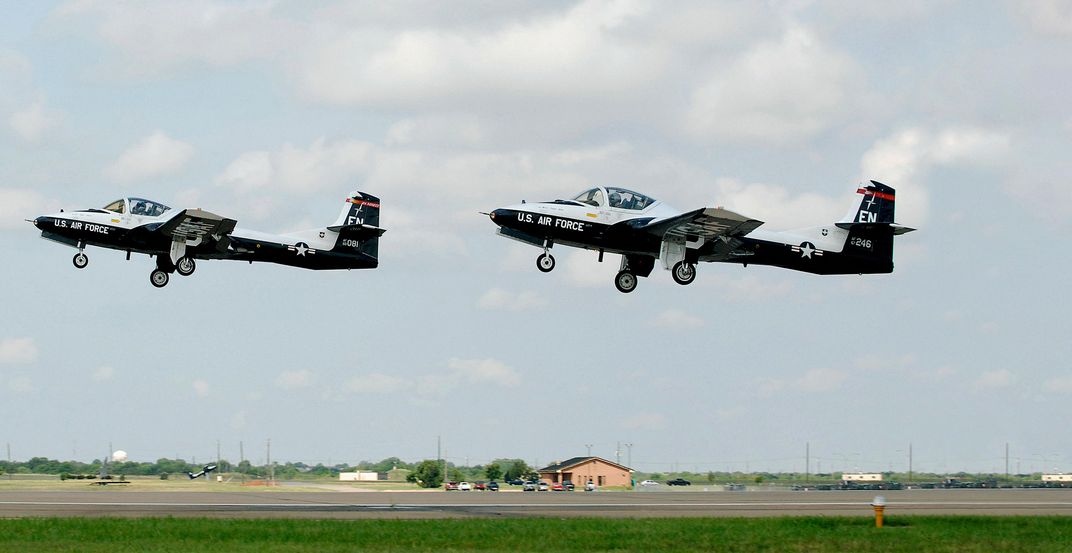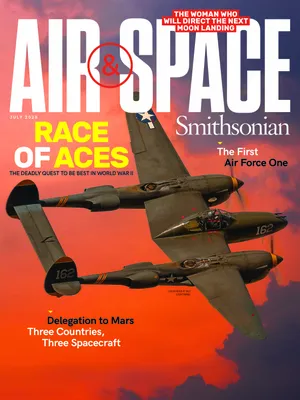Heather Penney Wasn’t Always a Hero. She Had to Learn How to Fail First.
The Cessna T-37 trainer is a fun airplane to fly, so why couldn’t I master this one simple procedure?
:focal(683x292:684x293)/https://tf-cmsv2-smithsonianmag-media.s3.amazonaws.com/filer/6d/ff/6dff7187-b165-4304-9033-052ac2054159/17c_jj2020_heatherpenney_live.jpg)
Heather Penney became known for a September 11, 2001 mission, when she was one of two pilots dispatched to ram the hijacked United Airlines Flight 93 with her unarmed F-16. Now a Senior Resident Fellow at the Mitchell Institute for Aerospace Studies, she recounts here a story from her days as a student pilot.
I was the only woman in my Air Force undergraduate pilot training flight, and I was humiliated.
I clenched my jaw, struggling to maintain military bearing. Fighting back tears, I saw horror in my instructor’s face at my emotional state as he tried to debrief me. The captain avoided my eyes and focused on the Dash-1 diagrams of the T-37 instrument panel, the Radio Magnetic Indicator (RMI), and the Instrument Flight Rules charts in between us. He continued describing the procedure for a Fix-to-Fix.
When flying a Fix-to-Fix, you don’t fly directly over any navigational station. You define your current location by a given radial and mileage from a navigational station, and then you find your way to another such point in space without flying directly to or over the navigational beacon. It’s not a method the Air Force teaches any longer, but it’s the sort of manual skill that denotes an old-school pilot. And in those days before electronic navigation, mastering it was utterly essential.
The captain was explaining this method to me, again, but I couldn’t hear him. All I heard was that I had flunked. I had hooked. I had taco’d.
My classmates turned away. Unable to see their faces, I imagined their thoughts: How stupid must she be that she can’t get a simple Fix-to-Fix? Not so smart now, huh? Can’t handle a little debrief, can’t be tough enough for combat. And crying? Does this girl even have what it takes to be a fighter pilot?
The “Unsatisfactory” grade on the bubble sheet the captain handed me meant that I would be doing this training flight again. He unceremoniously stood up and left to notify the flight commander. I was on the first step to washing out.
Short and squat, the Air Force’s T-37 trainer was not a hard aircraft to fly. In fact, despite being grossly underpowered, the “Tweet” was a joy. It was nimble, easy to land, quick to roll, fun to spin, and featured an impressive pitch-rate that had tricked many a student into over-G-ing the aircraft, subjecting the airframe to more stress than it was designed to bear. The Tweet remains one of my favorite aircraft.
What was not a joy was instrument flying in the T-37. The panel looked as if some engineer had puked gauges and dials onto it and wired them up where they splattered. The arrangement didn’t make sense. The cross check didn’t make sense. The instruments didn’t make sense. How the hell was anyone supposed to divine their location, much less execute a teardrop entry for three standard holding patterns and then intercept a localizer final approach—using a Radio Magnetic Indicator?
That night, I picked up my checklist, notes, flight profiles, and instrument approach plate and sat down on a chair in front of a large poster of the T-37 cockpit that was taped to my dining room wall.
Toilet plunger between my legs for a stick, I started the jet. Touching the poster’s images of knobs and buttons and saying out loud all the checklist’s challenges-and-responses, I mentally taxied the airplane to Sheppard’s Runway 33 Center, making all required radio calls and answering myself as if I were ground and tower. And then I took off.
But “chair-flying” instrument procedures wasn’t as effective as it was in our contact flight phase. The instruments on my poster didn’t move, and the instruments in my brain weren’t connecting either.
The next morning, I stared up at the flight scheduling board. I had been sat down, taken off the flying schedule. This was a customary punishment for hooking a ride in pilot training.
“Hey, Skippy. Tough ride, huh?”
Ajax, one of the other American students in my flight, stood behind me holding the SC-1 and SC-2 instrument approach books for airfields in Oklahoma and north Texas.
“One of the sims is open. Wanna go over and scrounge some time?”
I spent the next two days in the T-37 simulator flying the Instrument Landing System, going missed, holding, doing the localizer, the localizer back course, and yes, the dreaded Fix-to-Fix—the procedure I had failed. The guys in my class stepped up to help me, just like they did for each other. They had not judged me as harshly as I had judged myself. If one of the simulator instructor pilots wasn’t free to run me through the paces, my bros came and operated the console for me. And when all the sims were booked, I stood over their shoulders to watch from the side as they flew their instrument profiles.
There was no epiphany when the instrument panel suddenly and mystically revealed to me my location in the airspace. Those few days were just slogging, brute-force repetitions. But the actions of rote procedure slowly became a little less scripted and a little more natural. Gradually I fused together the information from each instrument to know where I was, where I needed to go, and what I needed to do.

Two days later, I flew with a different instructor, a major this time. It was a rinse-repeat of the flight I had hooked. I had flown this profile in all its variations what seemed like a million times in the last two days. Still, I was anxious, worried that I would fall apart under the pressure.
The taxi, takeoff, and departure were solid. I mentally graded my area work—steep turns, vertical S, wing-overs, aileron rolls, and unusual attitudes—as outstanding, hitting every airspeed, bank, heading, and altitude with precision. Maneuvering was one of my strengths.
Now I had to do what wasn’t: a Fix-to-Fix.
Tune, Identify, Monitor. I rolled 109.4 kilohertz into the navigation radio for the Lawton VOR beacons and selected the audio to hear the high pitch of the dot-dash-dot-dot / dot-dash / dot-dash-dash. Turning to a heading between the RMI pointer and the fix radial, I hedged closer to the bearing pointer to decrease my range to the destination point.
I mentally placed my aircraft on the tail of the bearing pointer and the destination fix at a proportional location on the radial of that destination fix. I then visualized a pencil connecting my plane to the fix and shifted it to the center of the RMI to find my no-wind heading.
The major was silent. I added a few degrees for wind correction and watched the distance measure count down and the RMI slowly rotate as we headed northwest and hit the fix. Finally, I breathed normally.
The rest of the flight was uneventful, as was my subsequent instrument check ride. I had a couple downgrades, but easily passed the most grueling check ride of the T-37 phase.
That hook turned out to be the most profound experience of my training. It forced me to dig deep inside myself to face failure and lift myself out of it. I discovered a determination and focus that would serve me well as a fighter pilot.
Despite the highly competitive nature of Air Force Pilot Training, my classmates supported me. As we progressed to more advanced techniques and aircraft—low-level navigation, formation, and eventually the T-38—I had the opportunity to give that support back to my classmates. In the cockpit, we were each solely responsible for our individual performance on every flight. But we were never alone.
